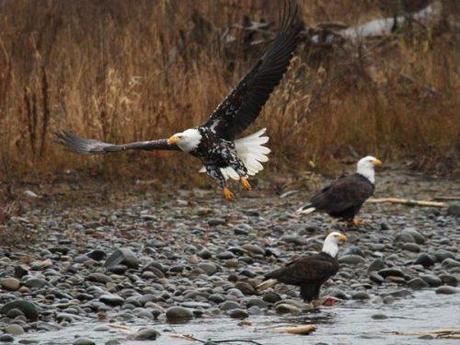
Nat Geo: Talk about an odd bird—a bald eagle with white spots has been seen in Washington State.
Photographers Chris Teren and Traci Walter snapped the bird feeding on the Nooksack River, near Bellingham, on January 6.
“It was chaotic, with eagles flying and calling everywhere, then in came this eagle. It didn’t take me long to figure out what we saw was something very special,” Walter told National Geographic News by email.
“I was so excited, but I contained myself and focused on this eagle, and wound up with some great shots. I have seen a couple leucistic animals before, and figured that’s what was going on.”
Indeed, the animal likely has leucism, according to Andrew Griswold, an expert on bald eagles and director of ecotravel for the Connecticut Audubon Society.
Leucism is a mutation that prevents melanin, or pigment, from being produced in parts of an animal’s body. In the case of birds, the pigment is absent from some feathers. Another condition that creates white coloration in animals is albinism, which occurs when an animal produces no melanin at all throughout its entire body.
Bald eagles on the cusp of adulthood have similar mottled feathers, but in this case, the bird has the telltale golden eyes and beak of an adult, added Teresa McGill, a wildlife photographer with McGill’s Nature in Motion. The pure-white head is also a sign of adulthood. “This is an extremely mature eagle, [and it's] not just going through its change of plumage. Beautiful!” McGill said by email.
Leucism is seen in many bird species, although it’s relatively rare, noted Patrick Comins, director of bird conservation for Audubon Connecticut. Their rarity may be because leucistic birds are at a disadvantage. Unless they live in snowy regions, their striking white color may be more noticeable to predators or prey and may also turn off members of their own species.
The recently photographed bald eagle probably doesn’t have trouble feeding or staying safe, since the large birds have few predators and scavenge their prey.
However, the fact that the bird looks like a teenager could be problematic, he said. The plumage “might give a signal to another eagle that’s a potential mate: This is not quite an adult bird, why would I want to mate with it?” Comins said.
Luckily, though, the bald eagle as a species is “a tremendous conservation success story,” he noted. Once federally endangered, the well-known bird has rebounded from an estimated 16,000 birds in 1999 to at least 26,000 in 2011.
Added photographer Walter, who has watched wildlife her whole life, the rare eagle “was a sighting I will never forget.”
You can see more amazing photos of this eagle at terenphotography.com.
Absolutely beautiful!
DCG

